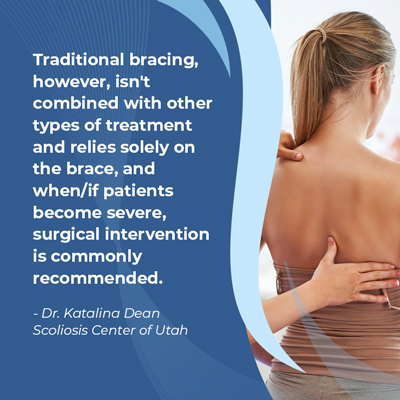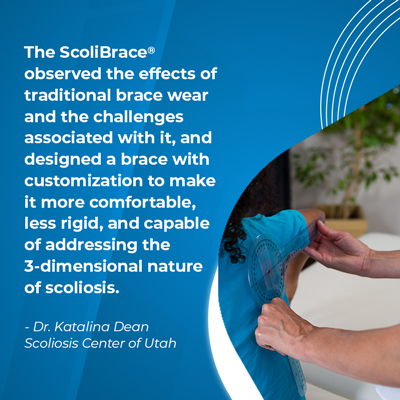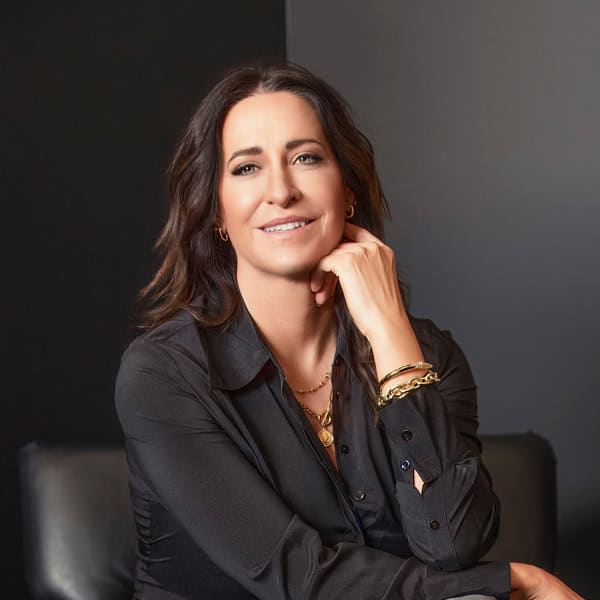Blogs
Scoliosis Braces for Adults: Types & Benefits Explained

Scoliosis bracing is more often used to treat childhood scoliosis because growing spines are more malleable and responsive, but there is also a place for bracing in adult scoliosis treatment. A modern corrective brace like the ScoliBrace® can offer significant pain relief, spinal stabilization, and postural correction.
Adult scoliosis bracing can help slow/stop progression, reduce curve size, stabilize the spine, and provide short-term pain relief. Bracing is a key facet of nonsurgical scoliosis treatment, and corrective bracing has the potential to significantly improve the spine’s position and postural alignment.
Before getting to the specifics of scoliosis bracing for adults, let’s talk about the two main types of adult scoliosis.
Adult Scoliosis
Scoliosis is more commonly diagnosed in children, but scoliosis affects all ages, including adults.
In fact, the actual rate of scoliosis increases among the aging population, and this is due to natural age-related spinal degeneration.
Adult scoliosis is diagnosed through a physical examination that includes taking a patient’s family history and performing an Adams forward bend test.
If an initial assessment shows indicators of an unnatural spinal curve with rotation, an X-ray is ordered to confirm what’s happening to the spine and its surroundings.
Not only does scoliosis range widely in severity from mild scoliosis to moderate and severe scoliosis, there are also different types from idiopathic scoliosis to neuromuscular and degenerative scoliosis, and the two most common types to affect adults are adolescent in adults (ASA) scoliosis and degenerative de-novo scoliosis (DDS).
Adolescent Scoliosis in Adults
Adults diagnosed with adolescent scoliosis have a pre-existing form of scoliosis; adolescent idiopathic scoliosis is the most prevalent type overall.
Adolescent idiopathic scoliosis is diagnosed usually around the onset of puberty, but its symptoms can be subtle, and as scoliosis doesn’t become compressive until skeletal maturity has been reached, childhood scoliosis isn’t commonly described as painful.
Particularly when mild, scoliosis symptoms can be subtle and difficult to detect.
As a progressive condition, the nature of scoliosis is to get worse, and growth spurts trigger the advancement of the unnatural spinal curve, making it more complex to treat.
In many of these cases, by the time I see the patient, significant progression has already occurred, and spinal rigidity can be a challenge, so physical therapy can be applied early to restore a certain degree of flexibility to make it more responsive to the next phase of treatment.
ASA can be progressive or stable, and if the scoliosis wasn’t diagnosed during adolescence, it can be more difficult to determine if it’s pre-existing scoliosis or de novo scoliosis.
Degenerative De-Novo Scoliosis
Degenerative scoliosis develops with no prior history and affects older adults around 45+ years old.
Degenerative scoliosis is caused by natural age-related spinal degeneration that most often starts in the intervertebral discs.
DDS develops due to increasing degenerative instability, and the more scoliosis progresses, the more danger there is of injury from a fall; an unstable and unbalanced spine can disrupt the balance and alignment of the entire body, making fall prevention a focus of adult DDS scoliosis treatment.
And because degenerative scoliosis is caused by degenerative instability, these cases are almost always progressive and painful, with lower back pain being the most common symptom of degenerative scoliosis.
So the challenges of treating scoliosis in adults include pain management and reducing the size of the unnatural spinal curve while improving its balance and stability, and this is where bracing comes in.
Scoliosis Bracing for Adults
Here at the Scoliosis Center of Utah, patients of all ages benefit from a complete and customized approach to care.
Just as no two cases of scoliosis are the same, there is no generic treatment plan for adult scoliosis; plans are designed around key elements such as patient age, experienced symptoms, condition type, severity, and location within the spine.
There are a number of scoliosis braces available from traditional bracing options like the Boston brace and the Providence brace to the modern corrective ScoliBrace®.
 Traditional bracing, however, isn’t combined with other types of treatment and relies solely on the brace, and when/if patients become severe, surgical intervention is commonly recommended.
Traditional bracing, however, isn’t combined with other types of treatment and relies solely on the brace, and when/if patients become severe, surgical intervention is commonly recommended.
Spinal fusion is invasive and risky, and when it comes to adult scoliosis, the risks only increase with age.
And traditional braces, like the Boston, are only 2-dimensional, leaving the spine’s rotation unaddressed.
Because scoliosis causes the spine to bend and rotate unnaturally, it’s a 3-dimensional condition, so successful treatment needs to provide a 3-dimensional solution.
ScoliBrace®
For qualifying patients, the corrective ScoliBrace® is customized through a number of scans, postural images, and comprehensive measurements, and a trained team of Clinicians are involved in the fittings and adjustments to ensure each brace is bespoke to its wearer.
What’s unique about the ScoliBrace® is that it represents the union of traditional and modern treatment goals.
While traditional braces have been around for hundreds of years and can help stop/slow progression, their potential was limited, and clinicians observed these shortcomings and designed what’s become known as the world’s most advanced scoliosis brace: ScoliBrace®.
3-dimensional Correction
 The ScoliBrace® observed the effects of traditional brace wear and the challenges associated with it, and designed a brace with customization to make it more comfortable, less rigid, and capable of addressing the 3-dimensional nature of scoliosis.
The ScoliBrace® observed the effects of traditional brace wear and the challenges associated with it, and designed a brace with customization to make it more comfortable, less rigid, and capable of addressing the 3-dimensional nature of scoliosis.
The ScoliBrace® uses spinal coupling to apply pressure to the curve to push the spine into a straighter alignment, and the effects of improving the spine’s alignment are felt in the body’s postural realignment.
In addition, the ScoliBrace® is designed with movement in mind, so it can be paired with a powerful exercise-based program for further results.
When it comes to bracing, I want patients to understand that its potential efficacy is not just tied to the brace, but also the treatment approach it’s associated with.
Here at the Center, integrative nonsurgical treatment pairs the ScoliBrace® with ScoliBalance® for more specific and complete treatment results.
Adult Bracing and Exercise-Based Treatment
When it comes to adult scoliosis treatment, bracing can help reduce the curve size, slow progression, stabilize the spine during wear, and provide short-term pain relief.
But bracing is limited because when the brace is off, the spine still needs to maintain its alignment, and this is where ScoliBalance® comes in.
ScoliBalance® is a unique and complete exercise-based treatment program that combines the best of Chiropractic BioPhysics® (CBP) and scoliosis-specific exercise.
Through a series of chiropractic techniques and manual adjustments, improving the spine’s alignment is worked towards, and when augmented by a corrective brace, this can impact the condition’s underlying structural nature, but those structural changes need to be supported.
The spine needs to be supported and stabilized by strong and balanced surrounding muscles, and ScoliBalance® can focus on balancing and strengthening the core muscles, along with teaching postural awareness for postural correction.
ScoliBalance® is customized to address the specifics of a patient’s scoliosis, so it has the potential for specific and precise results.
Largely through the use of customized Mirror Image exercise, patients are taught how to hold their spines and bodies in a straighter alignment; this can help sustain treatment results, correct the curve, slow progression, improve spinal stability, posture, reduce pain, and prevent falls.
So while no brace on its own will be able to impact scoliosis on multiple levels, when the ScoliBrace® is combined with Chiropractic Biophysics and ScoliBalance®, the scoliosis curve may be reduced, pain relief can be possible, and postural correction can improve the body’s balance and stability.
Conclusion
Adult scoliosis needs to be taken seriously, particularly when it comes to fall prevention in older adults.
The two main types of scoliosis to affect adults are adolescent scoliosis in adults and degenerative de-novo scoliosis.
Adolescent scoliosis in adults highlights the importance of early detection because many of these cases were undiagnosed and untreated during adolescence, progressing with time and growth into adulthood when scoliosis becomes compressive and can require pain management.
Pain is the main symptom of adult scoliosis and can involve muscle pain, back pain, and radiating pain into the extremities caused by compressed nerves.
Scoliosis pain can increase alongside progression, and if progression is occurring, the spine is becoming increasingly unbalanced and unstable, and the effects of a spinal misalignment will transfer to the body and cause a number of effects.
Postural changes, mobility changes, and pain are common effects, along with the development of an uneconomical gait that can further increase the uneven forces of scoliosis, so postural balance is important because it can mean less adverse spinal tension for improved biomechanics.
Corrective bracing has proven results, and when it comes to adult scoliosis, the ScoliBrace® and its accompanying treatment disciplines work together to significantly improve the spine’s position and stability.
Regardless of age, it’s never too late to start treatment that works towards improving quality of life, and the first step can be reaching out for assessment.

Dr. Katalina Dean
Dr. Katalina Dean is the founder and clinical director of Scoliosis Center of Utah, in Midvale, UT. Her team specializes in posture correction, spinal rehabilitation, and non-invasive scoliosis care and bracing.
Call Today
Do You Qualify for Care?
Schedule an Appointment Below
